warning SKODA FABIA 2006 2.G / 5J Manual Online
[x] Cancel search | Manufacturer: SKODA, Model Year: 2006, Model line: FABIA, Model: SKODA FABIA 2006 2.G / 5JPages: 258, PDF Size: 44.86 MB
Page 112 of 258
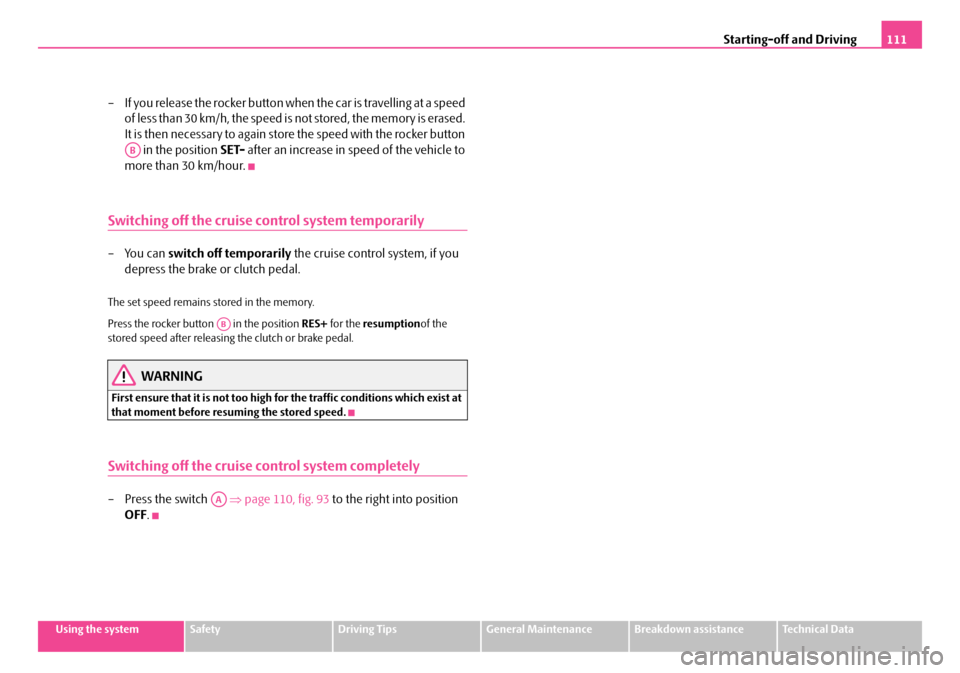
Starting-off and Driving111
Using the systemSafetyDriving TipsGeneral MaintenanceBreakdown assistanceTechnical Data
– If you release the rocker button when the car is travelling at a speed
of less than 30 km/h, the speed is not stored, the memory is erased.
It is then necessary to again store the speed with the rocker button
in the position SET- after an increase in speed of the vehicle to
more than 30 km/hour.
Switching off the cruise control system temporarily
– You can switch off temporarily the cruise control system, if you
depress the brake or clutch pedal.
The set speed remains stored in the memory.
Press the rocker button in the position RES+ for the resumptionof the stored speed after releasing the clutch or brake pedal.
WARNING
First ensure that it is not too high for the traffic conditions which exist at that moment before resuming the stored speed.
Switching off the cruise control system completely
– Press the switch ⇒page 110, fig. 93 to the right into position
OFF .
AB
AB
AA
NKO A05Fabia 20.book Page 111 Tuesday, September 26, 2006 8:38 AM
Page 114 of 258

Automatic gearbox113
Using the systemSafetyDriving TipsGeneral MaintenanceBreakdown assistanceTechnical Data
WARNING
•Do not depress the accelerator when changing the position of the selector lever if the car is stationary and the engine is running - risk of accident!
•Never move the selector lever into position R or P when driving - risk of an accident!
•When the engine is running and the vehicle is stationary, it is neces- sary to hold the car with the brake pedal in all the positions of the selector lever (except P and N) since the power transmission is never completely interrupted, also not when the engine is idling - the vehicle "creeps".
Selector lever positionsThe selector lever position you have engaged is shown in the information display of the instrument cluster with the corresponding gear symbol high- lighted ⇒fig. 95. In the positions D and S the gear you have already engaged will be additionally displayed on the display.
P - Parklock
The driven wheels are locked me chanically in this position.
The Parklock must only be engaged when the vehicle is stationary ⇒.
If you wish to move the sele ctor lever into or out of this position, you must press the Shiftlock button in the handle of the selector lever and at the same time depress the brake pedal.
R - Reverse
Reverse gear must only be engaged when the vehicle is stationary and the engine idling ⇒.
The brake pedal must be depressed and at the same time the Shiftlock must be pressed, if you wish to obtain the selector lever positions R, P or N.
Fig. 94 Selector lever
Fig. 95 Information display: Selector lever positions
NKO A05Fabia 20.book Page 113 Tuesday, September 26, 2006 8:38 AM
Page 115 of 258
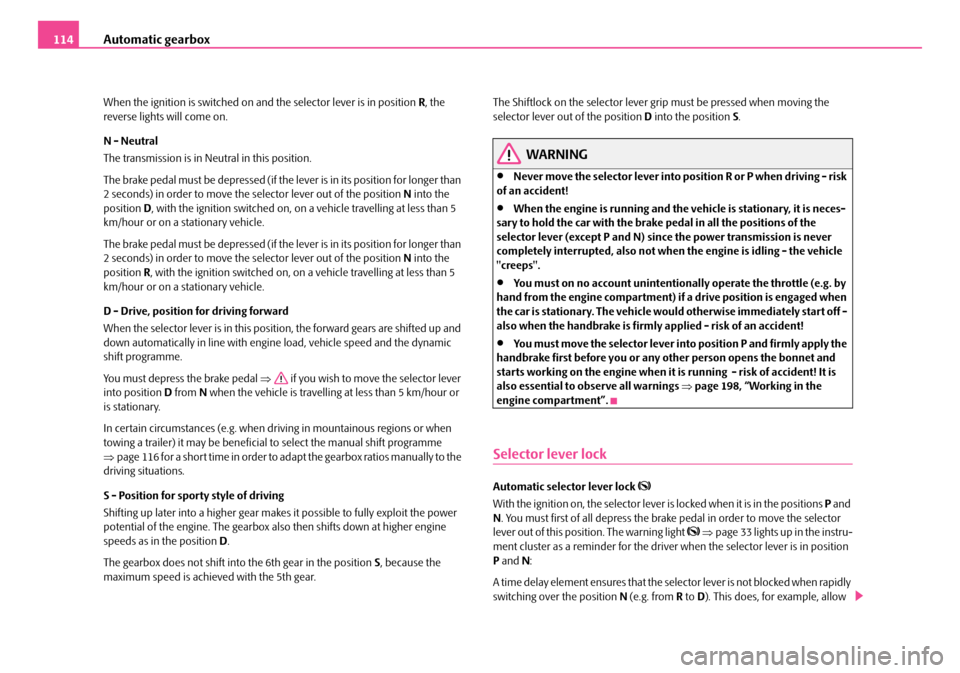
Automatic gearbox114
When the ignition is switched on and the selector lever is in position R, the reverse lights will come on.
N - Neutral
The transmission is in Neutral in this position.
The brake pedal must be depressed (if the lever is in its position for longer than 2 seconds) in order to move the se lector lever out of the position N into the position D, with the ignition switched on, on a vehicle travelling at less than 5 km/hour or on a stationary vehicle.
The brake pedal must be depressed (if the lever is in its position for longer than 2 seconds) in order to move the se lector lever out of the position N into the position R, with the ignition switched on, on a vehicle travelling at less than 5 km/hour or on a stationary vehicle.
D - Drive, position for driving forward
When the selector lever is in this position, the forward gears are shifted up and down automatically in line with engi ne load, vehicle speed and the dynamic shift programme.
You must depress the brake pedal ⇒ if you wish to move the selector lever into position D from N when the vehicle is travelling at less than 5 km/hour or is stationary.
In certain circumstances (e.g. when driving in mountainous regions or when towing a trailer) it may be beneficial to select the manual shift programme ⇒ page 116 for a short time in order to adapt the gearbox ratios manually to the driving situations.
S - Position for sporty style of driving
Shifting up later into a higher gear make s it possible to fully exploit the power potential of the engine. The gearbox also then shifts down at higher engine speeds as in the position D.
The gearbox does not shift into the 6th gear in the position S, because the maximum speed is achieved with the 5th gear.
The Shiftlock on the selector lever grip must be pressed when moving the selector lever out of the position D into the position S.
WARNING
•Never move the selector lever into position R or P when driving - risk of an accident!
•When the engine is running and the vehicle is stationary, it is neces- sary to hold the car with the brak e pedal in all the positions of the selector lever (except P and N) since the power transmission is never completely interrupted, also not when the engine is idling - the vehicle "creeps".
•You must on no account unintentionally operate the throttle (e.g. by hand from the engine compartment) if a drive position is engaged when the car is stationary. The vehicle wo uld otherwise immediately start off - also when the handbrake is firmly applied - risk of an accident!
•You must move the selector lever into position P and firmly apply the handbrake first before you or any other person opens the bonnet and starts working on the engine when it is running - risk of accident! It is also essential to observe all warnings ⇒page 198, “Working in the engine compartment”.
Selector lever lock
Automatic selector lever lock
With the ignition on, the selector lever is locked when it is in the positions P and N . You must first of all depress the brake pedal in order to move the selector lever out of this position. The warning light ⇒page 33 lights up in the instru- ment cluster as a reminder for the driver when the selector lever is in position P and N:
A time delay element ensures that the selector lever is not blocked when rapidly switching over the position N (e.g. from R to D). This does, for example, allow
NKO A05Fabia 20.book Page 114 Tuesday, September 26, 2006 8:38 AM
Page 116 of 258
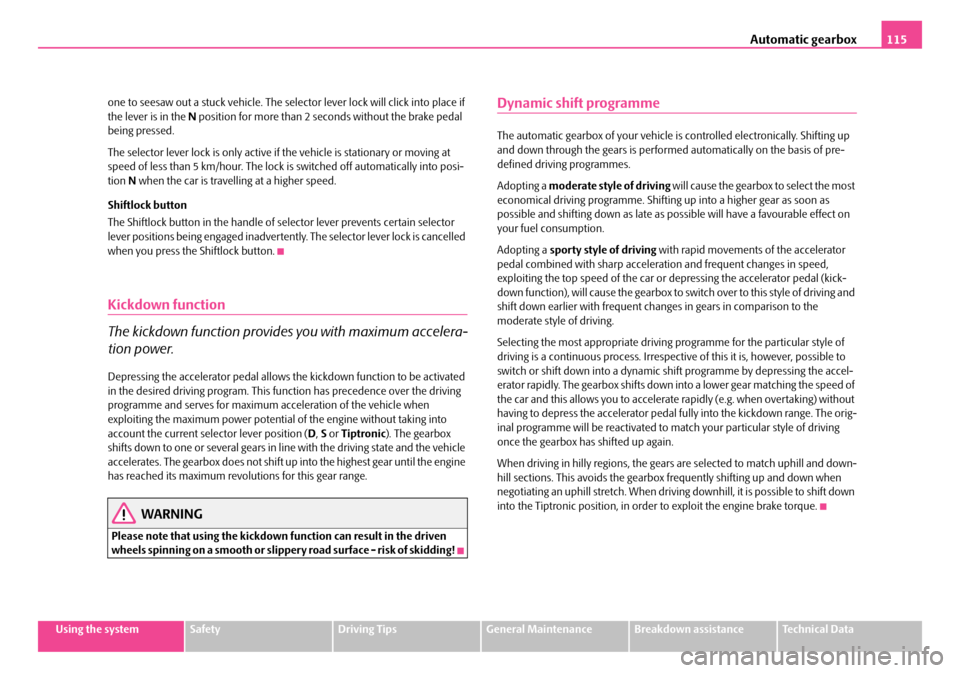
Automatic gearbox115
Using the systemSafetyDriving TipsGeneral MaintenanceBreakdown assistanceTechnical Data
one to seesaw out a stuck vehicle. The sele ctor lever lock will click into place if the lever is in the N position for more than 2 seconds without the brake pedal being pressed.
The selector lever lock is only active if the vehicle is stationary or moving at speed of less than 5 km/hour. The lock is switched off automatically into posi- tion N when the car is travelling at a higher speed.
Shiftlock button
The Shiftlock button in the handle of selector lever prevents certain selector lever positions being engaged inadvertently. The selector lever lock is cancelled when you press the Shiftlock button.
Kickdown function
The kickdown function provides you with maximum accelera-
tion power.
Depressing the accelerator pedal allows th e kickdown function to be activated in the desired driving program. This function has precedence over the driving programme and serves for maximum a cceleration of the vehicle when exploiting the maximum power potential of the engine without taking into account the current selector lever position ( D, S or Tiptronic). The gearbox shifts down to one or several gears in line with the driving state and the vehicle accelerates. The gearbox does not shift up into the highest gear until the engine has reached its maximum revolutions for this gear range.
WARNING
Please note that using the kickdown function can result in the driven wheels spinning on a smooth or slippery road surface - risk of skidding!
Dynamic shift programme
The automatic gearbox of your vehicle is controlled electronically. Shifting up and down through the gears is performe d automatically on the basis of pre- defined driving programmes.
Adopting a moderate style of driving will cause the gearbox to select the most economical driving programme. Shifting up into a higher gear as soon as possible and shifting down as late as possible will have a favourable effect on your fuel consumption.
Adopting a sporty style of driving with rapid movements of the accelerator pedal combined with sharp accelerati on and frequent changes in speed, exploiting the top speed of the car or depressing the accelerator pedal (kick- down function), will cause the gearbox to sw itch over to this style of driving and shift down earlier with frequent changes in gears in comparison to the moderate style of driving.
Selecting the most appropriate driving programme for the particular style of driving is a continuous process. Irrespective of this it is, however, possible to switch or shift down into a dynamic sh ift programme by depressing the accel- erator rapidly. The gearbox shifts down into a lower gear matching the speed of the car and this allows you to accelerate rapidly (e.g. when overtaking) without having to depress the accelerator pedal fu lly into the kickdown range. The orig- inal programme will be reactivated to ma tch your particular style of driving once the gearbox has shifted up again.
When driving in hilly regions, the gears are selected to match uphill and down- hill sections. This avoids the gearbox fr equently shifting up and down when negotiating an uphill stretch. When driving downhill, it is possible to shift down into the Tiptronic position, in order to exploit the engine brake torque.
NKO A05Fabia 20.book Page 115 Tuesday, September 26, 2006 8:38 AM
Page 122 of 258

Communication121
Using the systemSafetyDriving TipsGeneral MaintenanceBreakdown assistanceTechnical Data
•It is recommended to speak louder at higher speeds, so that the tone of your voice is louder than the increased surrounding noise.
•During the dialogue avoid additional noise in the vehicle, e.g. simultane- ously talking occupants.
•Do not speak, if the system makes an announcement.
•The microphone for voice control is directed to the driver and front passenger. Therefore the driver and the front passenger can operate the equip- ment.
WARNING
Pay attention primarily to the traffic situation! As the driver you are fully responsible for the traffic safety. Use the telephone system only to such an extent, so that you are in full control of your vehicle at any time.
Caution
Taking the mobile phone out of the adapte r during the call can lead to interrup- tion of the connection. When taking ou t the mobile phone, the connection to the factory-fitted antenna is interrupted, this reduces the quality of the trans- mitting and receiving signal. This might result additionally in harmful radiation from the mobile phone in the interior of the vehicle and the charging of the tele-phone battery is interrupted.
Note
•Please also refer to the additional instructions ⇒page 129, “Mobile phones and two-way radio systems”.
•Please contact your Škoda Service Part ner if there are any points which are not clear.
•The voice control of the telephone is only possible for adapters with PTT button. Suitable adapters are available at a Škoda Service Partner.
Inserting the mobile phone and adapter
A telephone mount is factory-fitted. The mount is attached to the
centre console. The adapter “Paragon - Fidelity” is offered as Škoda
Original Accessory.
Inserting the mobile phone and adapter
– First of all push the adapter in the direction of arrow ⇒fig. 101 up
to the stop into the mount. Press the adapter slightly downwards,
until it locks securely into position.
– Insert the mobile phone into the adapter (as specified in manufac-
turer's instructions).
Removing the mobile phone and adapter
– Press simultaneouly the side locks of the mount and remove the
mobile phone and adapter ⇒fig. 101.
Fig. 101 Universal prep- aration for the mobile phone
NKO A05Fabia 20.book Page 121 Tuesday, September 26, 2006 8:38 AM
Page 124 of 258

Communication123
Using the systemSafetyDriving TipsGeneral MaintenanceBreakdown assistanceTechnical Data
You can operate the mobile phone via the voice control ⇒page 120 or via the buttons of the multi-functional module* ⇒page 119.
Note
It a yellow or red warning symbol lights up in the information display, the menu phonebook cannot be selected.
Voice commands
Voice commands for mobile phone operation
Voice commands for operating the phone phone book
Other possible commands
Voice commandActivity
ENTER PIN/PIN CODEAfter this command the PIN code of the mobile phone can be entered ⇒page 124.
DIAL NUMBERAfter this command a telephone number can be entered which establishe s a connection to the requested partner ⇒page 124.
REDIALAfter this command the last selected telephone number is selected again ⇒page 125.
Voice commandActivity
SAVE/STORE NAMES/NAME/NUMB ER
After this command a name with its telephone number can be stored in the phone phone book ⇒ page 125.
SELECT NAMES/NAMEAfter this command a telephone number which was stored under its given name in the phone phone book can be selected ⇒page 126.
DELETE NAMES/NAMEAfter this command a name in the phone phone book can be erased ⇒page 127.
LISTEN TO/PLAY PHONEBOOKAfter this command you can listen-in to the phone phone book ⇒page 126.
DELETE PHONEBOOKAfter this command the complete phone book or a name can be erased ⇒page 127.
Voice commandActivity
DIALThe telephone number is selected.
STOREThe name and the telephone number are stored in the phone phonebook or the entered PIN code is stored.
REPEATThe entered name or the digits are repeated. Then the system requests with voice response “ please proceed ” the entry of further digits or commands.
NKO A05Fabia 20.book Page 123 Tuesday, September 26, 2006 8:38 AM
Page 130 of 258

Communication129
Using the systemSafetyDriving TipsGeneral MaintenanceBreakdown assistanceTechnical Data
with the hands-free system . If a fifth mobile phone is connected to the hands- free-system, then the telephone, which has been used together with the hands- free system for the shortest period, is disconnected.
Establishing the Bluetooth connection
After switching on the ignition, the Bluetooth connection is automatically established for the already adapted mobile phone 3). You can hear an increasing tone sequence from the loudspeakers of the vehicle.
Disconnecting the Bluetooth connection
After withdrawing the ignition key, the Bluetooth connection is disonnected. You can hear an increasing tone sequence from the loudspeakers of the vehicle.
WARNING
•Pay attention primarily to the traffic situation! As the driver you are fully responsible for the traffic safety . Use the telephone system only to such an extent, so that you are in full control of your vehicle at any time - risk of accident!
•In the event of air transport, the Bluetooth function of the handsfree-system must be switched off by a specialist garage.
Caution
Taking the mobile phone out of the adapter during the call can lead to interrup- tion of the connection. When taking ou t the mobile phone, the connection to the factory-fitted antenna is interrupted, this reduces the quality of the trans- mitting and receiving signal. This might result additionally in harmful radiation from the mobile phone in the interior of the vehicle and the charging of the tele- phone battery is interrupted.
Note
•Not valid for all mobile phones whic h enable a communication via Blue- tooth.
•Please operate your mobile phone excl usively with a suitable adapter, in order to keep a low radiation in the vehicle.
•Inserting the mobile phone into the adapter ensures an optimal sending and receiving power and offers at the sa me time the advantage of the battery charging.
•If you insert the mobile telephone into the adapter, the connection is estab- lished via the interface in the adapte r set and the Bluetooth connection is disconnected. You can hear an increa sing tone sequence from the loud- speakers of the vehicle.
•Note that the range of the Bluetooth connection to the handsfree-system is limited to the vehicle interior. The rang e is dependent on local factors, e.g. obstacles between the devices and interferences with other devices. If your mobile phone is e.g. in a jacket pocket, th is can lead to difficulties when estab- lishing the Bluetooth connection with the handsfree-system or the data transfer.
•If you have set the Portugue se language in the information display, it is used automatically for the mobile phone operation, as this is the language, which was entered during coding of the handsfree-system.
Mobile phones and two-way radio systems
We recommend that you have the installation of a mobile phone and two-way radio system in a vehicle carried out by a Škoda Service Partner.
Škoda Auto a.s. permits the operation of mobile phones and two-way radio systems with a professionally installed external aerial and a maximum transmis- sion power of up to 10 watts.
Our Škoda Service Partners are also happy to inform you about the possibilities available for installing and operating mobile telephones and radio transmitters which have an output greater than 10 watts. The Škoda Service Partners can provide you with details about the technical possibilities for retrofitting of mobile telephones and radio transmitters.
NKO A05Fabia 20.book Page 129 Tuesday, September 26, 2006 8:38 AM
Page 131 of 258
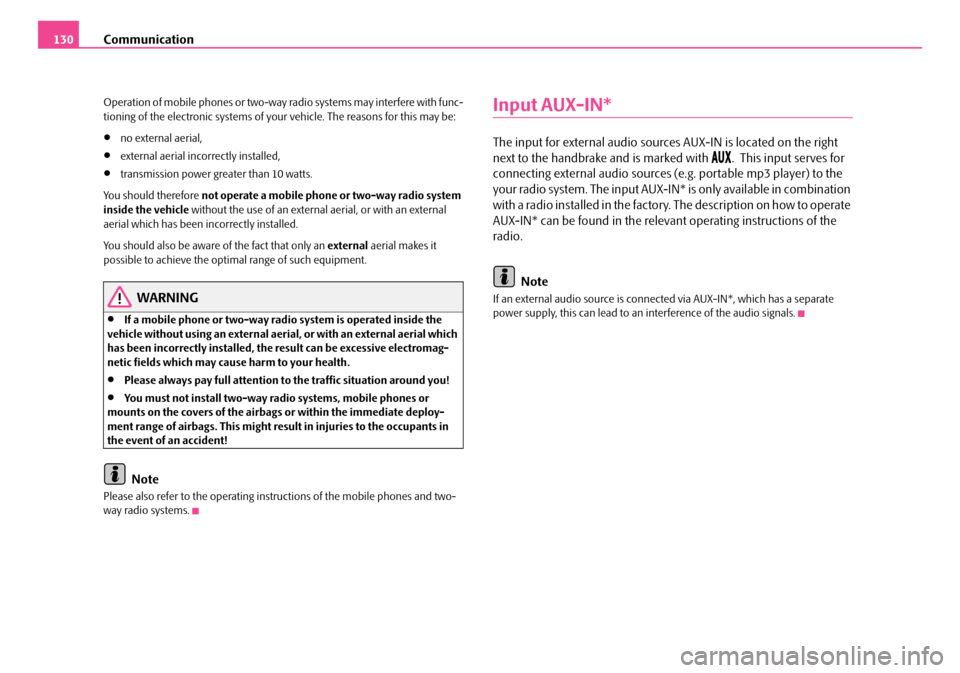
Communication130
Operation of mobile phones or two-way radio systems may interfere with func- tioning of the electronic systems of your vehicle. The reasons for this may be:
•no external aerial,
•external aerial incorrectly installed,
•transmission power greater than 10 watts.
You should therefore not operate a mobile phone or two-way radio system inside the vehicle without the use of an external aerial, or with an external aerial which has been incorrectly installed.
You should also be aware of the fact that only an external aerial makes it possible to achieve the optimal range of such equipment.
WARNING
•If a mobile phone or two-way radio system is operated inside the vehicle without using an external aerial , or with an external aerial which has been incorrectly installed, the result can be excessive electromag- netic fields which may cause harm to your health.
•Please always pay full attention to the traffic situation around you!
•You must not install two-way radio systems, mobile phones or mounts on the covers of the airbags or within the immediate deploy- ment range of airbags. This might resu lt in injuries to the occupants in the event of an accident!
Note
Please also refer to the operating inst ructions of the mobile phones and two- way radio systems.
Input AUX-IN*
The input for external audio source s AUX-IN is located on the right
next to the handbrake and is marked with . This input serves for
connecting external audio sources (e.g. portable mp3 player) to the
your radio system. The input AUX-IN* is only available in combination
with a radio installed in the factory. The description on how to operate
AUX-IN* can be found in the releva nt operating instructions of the
radio.
Note
If an external audio source is connected via AUX-IN*, which has a separate power supply, this can lead to an interference of the audio signals.
NKO A05Fabia 20.book Page 130 Tuesday, September 26, 2006 8:38 AM
Page 133 of 258
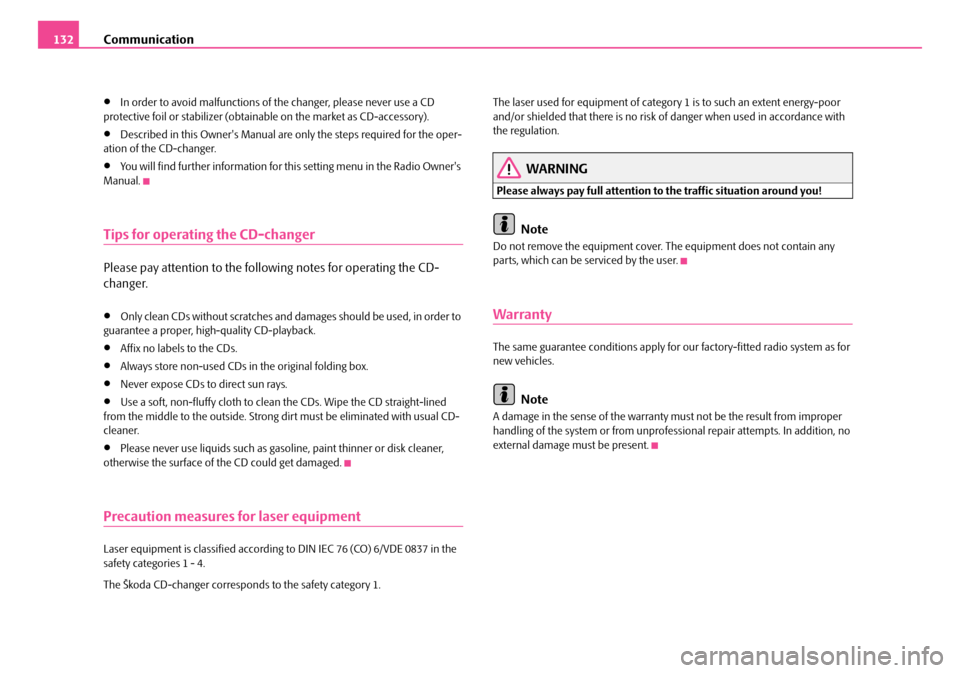
Communication132
•In order to avoid malfunctions of the changer, please never use a CD protective foil or stabilizer (obtai nable on the market as CD-accessory).
•Described in this Owner's Manual are only the steps required for the oper- ation of the CD-changer.
•You will find further information for this setting menu in the Radio Owner's Manual.
Tips for operating the CD-changer
Please pay attention to the follo wing notes for operating the CD-
changer.
•Only clean CDs without scratches and damages should be used, in order to guarantee a proper, high-quality CD-playback.
•Affix no labels to the CDs.
•Always store non-used CDs in the original folding box.
•Never expose CDs to direct sun rays.
•Use a soft, non-fluffy cloth to clean the CDs. Wipe the CD straight-lined from the middle to the outside. Strong dirt must be eliminated with usual CD- cleaner.
•Please never use liquids such as gasoline, paint thinner or disk cleaner, otherwise the surface of the CD could get damaged.
Precaution measures for laser equipment
Laser equipment is classified according to DIN IEC 76 (CO) 6/VDE 0837 in the safety categories 1 - 4.
The Škoda CD-changer correspond s to the safety category 1.
The laser used for equipment of category 1 is to such an extent energy-poor and/or shielded that there is no risk of danger when used in accordance with the regulation.
WARNING
Please always pay full attention to the traffic situation around you!
Note
Do not remove the equipment cover. The equipment does not contain any parts, which can be serviced by the user.
Warranty
The same guarantee conditions apply for our factory-fitted radio system as for new vehicles.
Note
A damage in the sense of the warranty must not be the result from improper handling of the system or from unprofessi onal repair attempts. In addition, no external damage must be present.
NKO A05Fabia 20.book Page 132 Tuesday, September 26, 2006 8:38 AM
Page 134 of 258

Passive Safety133
Using the systemSafetyDriving TipsGeneral MaintenanceBreakdown assistanceTechnical Data
Safety
Passive Safety
Basic information
Driving the safe way
Passive safety measures reduce the risk of injury in accident
situations.
In this section you will find important info rmation, tips and notes on the subject of passive safety in your vehicle. We have combined everything here which you should be familiar with, for example, re garding seat belts, airbags, child seats and safety of children. It is therefore important, in particular, to comply with the notes and warnings in this section for your own interest and in the interest of those travelling with you.
WARNING
•This chapter contains important information on how to use the vehicle for the driver and his occupants. You will find further information on safety, which concerns you and those travelling with you, in the following chapters of this Owner's Manual.
•The complete on-board literature should always be in the vehicle. This applies in particular, if you rent out or sell the vehicle.
Safety equipment
The safety equipment is part of the occupant protection and it
can reduce the risk of injuries in accident situations.
“Do not put at risk” your safety and the sa fety of those travelling with you . In the event of an accident, the safety equipmen t can reduce the risk of injuries. The following list contains part of the safety equipment in your vehicle:
•Three-point seat belts for all the seats,
•belt force limiter for front seats,
•belt tensioner for front seats,
•seat belt height adjuster for front seats,
•front airbag for the driver and the front seat passenger*,
•Side airbags*,
•head airbags*,
•anchoring points for child seat using the “ISOFIX” system,
•anchoring points for child seat using the “Top Tether” system,
•head restraint adjustable for height,
•adjustable steering column.
The specified safety equipment works together, in order to optimally protect you and those travelling with you in a ccident situations. The safety equipment does not protect you or the people travelli ng with you, if you or your occupants adopt an incorrect seated position or th e equipment is not correctly adjusted or used.
NKO A05Fabia 20.book Page 133 Tuesday, September 26, 2006 8:38 AM